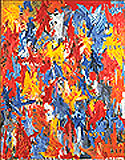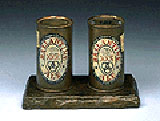Assignment Background
Johns' first painting, and in many respects his most important work, was Flag (1955). Simply put, his bold rendering of the American flag took up an entire "canvas" (done in encaustic--pigment mixed with hot wax--oil and collage on fabric mounted on three plywood panels, 42 1/4" x 60 5/8"). People did not know how to view,or understand, the painting, since it seemed simply to be a "flag." But the painting, in its "everydayness," became one of the defining images of the Pop Art movement. Johns soon began to paint popular and simple objects, beer cans, brushes, an archery target, maps, letters of the alphabet--Johns claimed that there were really no hidden symbolic references in his work--in order to highlight the differences and similarities between a real object and its painted image. This "real imagery" was a radical break from the Abstract Expressionist movement of the 1950s. In January 1958 the Leo Castelli Gallery (owned by Leo Castelli) in New York held Johns' first solo exhibition at which the Museum of Modern Art (MOMA) acquired three of Johns' works. The MOMA purchase clearly established Johns as a growing presence in the art world. In the 1960s Johns began to move away from his earlier work on and use of representational real imagery. While continuing to paint "objects," he also introduced sculptural elements into his work by affixing ordinary things, such as beer cans and light bulbs, to the surface of his canvases. He also began to be interested in printmaking, especially as a medium that allowed for experimentation and repetition. Through the 1970s, Johns explored altered formats to produce some of the largest paintings of his career. He created paintings composed of clusters of parallel lines that he called "cross-hatchings," such as his four-panel work Untitled (1972). These "cross-hatched" paintings clearly indicated that Johns had moved from the depiction of the everyday object (Pop Art) into the realm of the abstract, with a new (for Johns) focus on technique and the painting process. By the 80s, Johns' work had changed again, partly as a result of his interest in Pablo Picasso. Many of his paintings from this time bear autobiographical and emotional imprints. By the 1990s, Johns struck out again on a bizarre new direction. Green Angel (1990), for example, challenged the viewer to focus attention on the transformed image. Timeline
Websites
Recommended Books
Related Events |
|||||||||||||||||||||||

